Circles over "Leahy"
Deep modernization of project 1155 - Admiral Chabanenko. On the navy Such one. An order for two destroyers of this type was canceled in 1993. However, it makes sense to include project 1155.1 in the review as the pinnacle of Soviet shipbuilding in the BOD class. So, we compare. According to the concept, both ours and the “Frenchman” are the last in the first post-war generation. They do not yet have the UVP, other technical equipment and weapons characteristic of the next-generation destroyers, like the Orly Burke, but they are the crown for their time.
When comparing, as usual, we will not only analyze their weapons and other TTDs, but also look at meeting the criteria for combat use, based on the already proven methodology.
The first post-war
Today in the Russian Navy eight BOD project 1155. By the 1991, they were built 12, four have already been disposed of. Full displacement - about 7500 tons. The gas turbine power plant is mixed with two marching GTEs of nine thousand horsepower and two afterburners of 25 250 horsepower, which provides the maximum speed of the 32 node. The range at 14 nodes is about five thousand miles. Powerful weapons against submarines. The main anti-submarine complex is “Rastrub-B” with eight PLUR 85-RU in two four-container PU located in the middle of the ship along the sides, the firing range is up to 90 kilometers. The warhead is represented by the UMHT-1 anti-submarine torpedo with a range of up to eight kilometers and a speed of 41 knot. The rocket is remote-controlled until the torpedo discharge. The speed - 290 meters per second with a height of flight to the submarine - about 400 meters. This is a universal anti-submarine complex, it can also be used to defeat surface targets, the flight to which takes place at an altitude of about 15 meters. However, we recognize these capabilities as modest - the torpedo has a small warhead, relatively large rocket dimensions and low flight speed with a limited range of fire. In addition to the PLUR “Rastrub-B” BOD 1155 has an anti-submarine missile complex “Waterfall” with two four-tube 533-mm TA with PLUR 83-РН instead of torpedoes СЭТ-65. The ship has two twelve-barreled RBU-6000 and two Ka-27PL anti-submarine helicopters located in the stern hangar, which can issue target designations for the Rastrub.
To search for submarines on the ship, the Polkina under-the-hack is installed, approximately equal to the first modifications of the American AN / SQS-53 SAC, providing detection in active mode of submarines with favorable sonar conditions at a distance of up to 30 kilometers. There is a towed GUS, allowing you to search for submarines under the jump layer. BOD is armed with two short-range multi-channel Dagger SAMs with 64 missiles in two DPS in the bow and stern of the ship, beating up to 12 kilometers. Each complex can simultaneously fire four targets with two missiles aimed at each.
For defense against airborne internal air forces, there are two batteries of two six-barrel AU MZA AK-630 caliber 30 millimeters. Overview of the air provides a three-coordinate radar MP-145 "Frigate". To suppress the operation of the EFV REs (in particular, the SCN PKR), the RPC MP-401 and SAP MP-407 stations, as well as the PC-2М and PC-10 systems, are installed on the BOD, for setting passive jamming. Artillery - two 100-mm AU AK-100 with the control system Lev-114. The maximum firing range is up to 22 kilometers at speeds up to 60 projectiles per minute from each AU.
In the 1155.1 BOD project, the total displacement has increased by almost 1400 tons - to 8900. The power plant is the same, which reduced the maximum speed to 30 knots and the range in economic mode - to 3300 miles.
The anti-submarine missile system "Rastrub-B" was replaced by the anti-ship missile "Moskit", which translated the BOD into multi-purpose ships. It has eight (two sloping launchers with four cells each side), supersonic anti-aircraft missiles “Mosquito” with a range of fire at extremely low altitudes (20 – 30 meters) about 170 kilometers (with the modification “Mosquito-M”). Overall missile: the launch weight of 3930 kilograms, speed at all stages is about 1000 meters per second, which makes the ammunition invulnerable to the vast majority of modern air defense systems (even the American air defense system of the Idzhis BI system is not sufficiently effective in this case) - about 300 kilograms. Targeting outside the horizon is issued from the Mineral complex and according to external sources of information.

The air defense of the ship has changed, six ZAK AK-630 were replaced by two more effective ZRAK "Dagger" (with 128 SAM and 24 rounds for a 000-mm AC). Accordingly, the main anti-submarine missile system became the “Waterfall” with 30-RN or 83-RN PLURs with a firing range of up to 84 kilometers. The warhead of the PLUR is the same - UMGT-50. The firing of the PLUR is carried out from two four-pipe 1 mm TA, which is also used by the project 533 BOD. The total ammunition of the Vodopad PLUR and the SET-1155 torpedoes are 65 units. Instead of two RBU-24 ships received two ten-barrel RBU-6000, mainly for protection against torpedoes. Search facilities for submarines have been strengthened - instead of the Polynomial, the Zvezda-12000 GAC has been installed. Aviation armament is the same.
Artillery - 130-mm AU AK-130 with MP-184 "Lev-184" fire control system instead of two AU-AK-100. The maximum firing range is up to 24 kilometers with fire performance up to 90 projectiles per minute from the installation, that is, about three tons per minute. For comparison: the cruiser Tikonderoga produces about two tons, and the destroyer Orly Burk - a little more than a ton. Therefore, the BOD project 1155.1 in the status of the most powerful artillery ships in the world, second only to the destroyers of the project 956.
Seven George Leahy type destroyers of smaller displacement: full - 4580 tons. They have a mixed power plant of two low-noise diesel engines for the economic course and two GTE - for maximum. The total power - 52 is thousands of horsepower, which provides the maximum speed of 30 nodes. By an economic move (18 nodes) the destroyer will pass 8500 nautical miles.
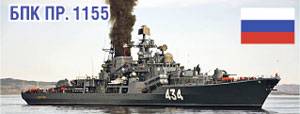
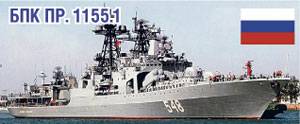
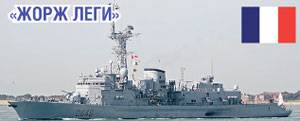 The antisubmarine armament complex consists of two 550-mm TAs with 10 torpedo ammunition. This is significantly less than the destroyer of the 1155 project. Two anti-submarine helicopters "Lynx" in the stern hangar - the main means of destruction of submarines. To search for submarines on the ship, there is a podkilnaya GAS DUBV 23D or DUBV 24С, corresponding to the American GUS AN / SQS-26, significantly inferior in the detection range of the underwater targets SJC Polynom and the more so Zvezda-2.
The antisubmarine armament complex consists of two 550-mm TAs with 10 torpedo ammunition. This is significantly less than the destroyer of the 1155 project. Two anti-submarine helicopters "Lynx" in the stern hangar - the main means of destruction of submarines. To search for submarines on the ship, there is a podkilnaya GAS DUBV 23D or DUBV 24С, corresponding to the American GUS AN / SQS-26, significantly inferior in the detection range of the underwater targets SJC Polynom and the more so Zvezda-2.The "French" towed GAS DUBV 43В (it is equipped with the first three ships) or DUBV 43С (subsequent in the series). The antenna sinks to 700 meters at the speed of the carrier ship to 18 nodes, which allows searching for submarines under the jump layer at any depths of its probable occurrence. The only ship of this type equipped with a GUS with a flexible long towed antenna DUBV 61В - Primauquet. The rest of such hydroacoustic stations do not have. We believe that the French have not brought this gas to the level when it can be equipped with ships of at least this type. Therefore, for analysis, we take the most massive version of hydroacoustic weapons - the rocker and towed GUS. Anti-torpedo protection is represented by the American system of active hydroacoustic interference AN / SLQ-25 and four floating false targets. We recognize that in anti-submarine weapons, French destroyers are significantly inferior to our BOD.
And air defense can not be called strong. After the modernization of the first four destroyers of the series, the main air defense system was the Sadral air defense system with a six-container PU for Mistral missiles and 36 ammunition with an infrared seeker with a range of up to six kilometers with a reach of only three kilometers. Infrared homing system is ineffective in adverse weather conditions. This also significantly reduces its chances of infecting anti-ship missiles attacking the ship: firing will be conducted in the forward hemisphere of the target, where infrared radiation is minimal.
For the destruction of the air defense system in the defense zone on the destroyers are two 30-mm Breda / Mauser machine guns. Main weapon Air defense on other ships - the NAVAL Krotal air defense missile system, an eight-container PU of which is located above the aft helicopter hangar. Ammunition - all 24 missiles with radio command guidance with a range of 10 kilometers when reachable at an altitude of about six thousand meters. There are twin Simbad PU for Mistral missiles with 12 missile ammunition. MZA for the destruction of air attack weapons in the zone of self-defense, judging by the open data, no. Anti-ship missile weapons initially were not. However, after the upgrade, two paired PUs for the Exocset ASM MM-40 appeared. Its most advanced modification with a firing range of about 180 kilometers with a combat unit 165 kilograms. Goes to the target at low and extremely low altitudes. But it is possible to shoot beyond the horizon only with external target designation from regular Lynx helicopters. For hitting surface and coastal targets - single-barreled 100-mm AU CADAM Mk 68-II with a firing range of up to 20 kilometers. There is an SSR with radar and an optoelectronic sight, as well as an infrared sensor.
Note that the "Frenchman" surpasses the BOD of the 1155 project only in anti-ship armament. In all other respects it is inferior, especially the BN of the 1155.1 project in the field of air defense and anti-submarine weapons. “Georges Leahy” does not have PLUR, and the anti-submarine torpedo ammunition is small. For the range of the GAK, both our ships are superior to the “Frenchman”. Its air defense systems have four times less targeted air defense missile systems than BOD. In this case, the SAM missile is half as large as that of the 1155 project ship, and five times less than that of the 1155.1 project. With approximately equal range of firing, the “Mosquito” anti-ship missile missile BN of the 1155.1 project overcomes the air defense system much more effectively. Our ship has its own means of over-the-horizon target designation, which the Frenchman does not have.
However, the conditions of combat use vary, and it may be that the "Frenchman" more closely matches them than the Russian BOD. Let us assess the capabilities of ships in a local war against a weak enemy and in a large-scale against a strong state.
Who whom than
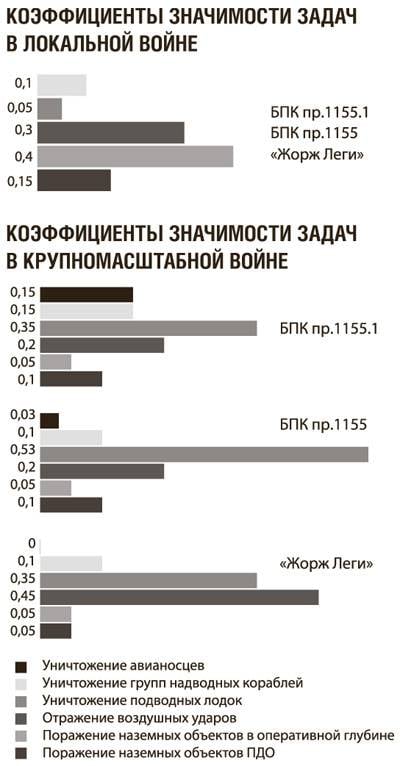 In conflicts, the ships will be engaged in the destruction of groups of surface ships (KUG and KPUG) and submarines, the reflection of the EAS, strikes at ground targets. Note that the Russian BOD project 1155.1 may occasionally hit the US aircraft carrier. Although in the oncoming battle, there is almost no chance of reaching a salvo position. But the opportunity to hit the "American" from the position of tracking weapons is real. As for the "Frenchman", then the meeting hardly shines for him - the only Russian aircraft carrier will hardly operate where Georges Leghie can act.
In conflicts, the ships will be engaged in the destruction of groups of surface ships (KUG and KPUG) and submarines, the reflection of the EAS, strikes at ground targets. Note that the Russian BOD project 1155.1 may occasionally hit the US aircraft carrier. Although in the oncoming battle, there is almost no chance of reaching a salvo position. But the opportunity to hit the "American" from the position of tracking weapons is real. As for the "Frenchman", then the meeting hardly shines for him - the only Russian aircraft carrier will hardly operate where Georges Leghie can act.The distribution of coefficients of significance of tasks is determined by the nature of the conflict and the characteristics of the struggle during its resolution by the likely composition of the Navy groupings engaged in combat operations, their operational and tactical tasks, as well as the specifics of the combat mission of this class of ships.
Therefore, the distribution of the weighting coefficients of tasks in a local war against a weak enemy can be estimated in the same way for Russian and French destroyers: the destruction of groups of surface ships and boats - 0,1, submarines - 0,05, reflection of HVS - 0,3, striking ground targets in operational depth - 0,4, on objects of antiamphibious defense - 0,15.
In a large-scale war, the weights are distributed differently. Task coefficients for BOD project 1155.1: destruction of aircraft carriers - 0,15 (including from the position of tracking weapons - 0,03, in the oncoming battle - 0,12), KUG and KPUG - 0,15 and submarines - 0,35; EHV reflection - 0,2; strikes against ground targets in the operational depth - 0,05, against PDO objects - 0,1. For the BOD project 1155: the destruction of aircraft carriers - 0,03 (from the position of tracking weapons - 0,01, in the oncoming battle - 0,02), KUG and KPUG - 0,1 and submarines - 0,53; EHV reflection - 0,2; strikes on ground targets in operational depth - 0,05, on PDO targets - 0,1. For the Frenchman, the distribution of the significance of the tasks is as follows: the destruction of aircraft carriers - 0,0; destruction of KUG and KPUG - 0,1 and submarines - 0,35; EHV reflection - 0,45; strikes against ground targets in the operational depth - 0,05, against PDO objects - 0,05.
Evaluate the capabilities of BOD and destroyers in solving typical problems. The destruction of aircraft carriers is relevant only for Russian BOD. In the oncoming battle with a combat-ready aircraft carrier group, they have no chance of firing a volley. The ability of the 1155 BOD project to hit an aircraft carrier from the weapons tracking position is insignificant — a strike of several missiles with a warhead of a small anti-submarine torpedo at low speed cannot cause damage, since the AUG air defense system will destroy all attacking targets almost guaranteed. The probability of hitting an aircraft carrier with a salvo of 85-RU with the BOD of the 1155 project is zero. But the defeat of an aircraft carrier in eight volley “Mosquitoes” from the position of tracking weapons is very real. After all, this missile since its appearance over the radio horizon leaves air defense systems less than 15 seconds to reflect the impact. The Aegis reaction time from the moment of the detection of airborne forces before the launch of missiles is more than 12 seconds (Aegis reacts to 7 – 8 seconds and another not less than 5 seconds - the working time of the missile complex, moreover from readiness No. 1). Thus, in the most favorable case, the defense will be able to release one missile defense system with each launcher and hit, at best, one anti-ship missile "Mosquito". Part of the pack may be taken away by interference. An aircraft carrier will reach an average of three to five missiles - this is enough to disable it, which corresponds to the probability of solving the 0,6 – 0,7 problem.
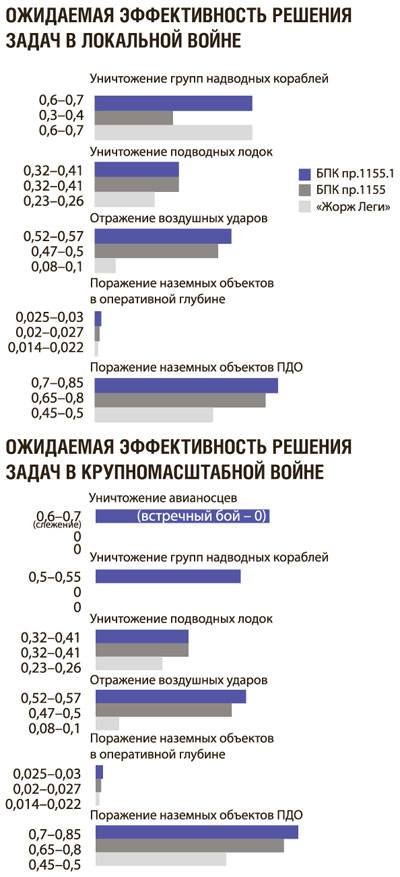 Another task is the destruction of groups of surface ships. Consider the same composition as when comparing the destroyers of the United States and China. Take a typical KTUG (KUG) of three or four units of the frigate class. At the same time, the object of attack of the Russian ships will be, of course, the NATO members, for example, the Horizon type, and for the Frenchman, our most modern ships of this class of the 22350 project (they may end up in the Mediterranean Sea with the start of the war, for example, at the Tartus base station).
Another task is the destruction of groups of surface ships. Consider the same composition as when comparing the destroyers of the United States and China. Take a typical KTUG (KUG) of three or four units of the frigate class. At the same time, the object of attack of the Russian ships will be, of course, the NATO members, for example, the Horizon type, and for the Frenchman, our most modern ships of this class of the 22350 project (they may end up in the Mediterranean Sea with the start of the war, for example, at the Tartus base station).The 1155.1 project ship is approximately equal in range of its missiles with possible targets armed with the Harpoon missiles. However, it has the advantage of the over-the-horizon target designation “Mineral”. Therefore, all other things being equal (about the same effectiveness of external targeting), our BOD has more chances to preempt. Shooting eight "Mosquitoes" in a group of three or four NATO frigates can disable or sink at least two or three ships, which corresponds to the effectiveness of 0,65 – 0,75. If the enemy strikes with a pre-emption, then he will be able to release the 8 – 12 RCC “Harpoon”, which will lead to the likelihood of the destruction or sinking of our ship 0,25 – 0,4. Given the likelihood of pre-emption in the salvo, the overall effectiveness of the fight against surface ships of the BOD project 1155.1 can be assessed in 0,5 – 0,55.
Missiles 85-RU BOD project 1155 more than twice inferior enemy missiles "Garpun" in range. Therefore, all other things being equal, there is almost no chance of a preemptive strike. A volley from 8 – 12 “Harpoons” can disable or sink our BOD with probability 0,35 – 0,4. The estimated effectiveness of the impact of eight 85-RU missiles in several successive salvoes (taking into account the limitations of the missiles in the salvo determined by the control system) for a group of three or four NATO frigates is estimated by the mathematical expectation of the number of disabled or sunk ships in 0,08 – 0,1, which corresponds to 0,02 efficiency –0,03. We take into account that the enemy will not enter the zone of destruction of our BOD, if he retains his combat capability. Thus, a strike on the enemy’s KPUG is possible if it is not detected before entering the salvo position, which is highly unlikely. And given the low chance of hitting a CPUG with 85-RU missiles, it is possible to recognize the expected efficiency of solving a zero problem.
Opponent "Georges Leghie" - the frigate of the 22350 project has at least one and a half superiority in missile range. Therefore, under equal conditions, a group of three or four frigates will not leave a single destroyer a chance to even simply survive. Obviously, the effectiveness of the solution of the task of fighting surface ships in a large-scale war with the "Frenchman" will also be zero.
In local conflicts, the target of the strike will be groups of three or four boats or ships of the near-sea zone that have short-range anti-ship missiles and without effective air defense weapons. In the fight against them, the BOD of the 1155.1 project and the destroyer Georges Leahy are gaining about the same number of points - 0,6 – 0,7. In the BOD project 1155, the indicators are significantly lower - 0,3 – 0,4, which is determined by the lower probability of hitting a highly maneuverable small-sized target with 85-RU missiles.
In strikes on ground targets, our BOD and the “Frenchman” will have to solve a tactical task — to disable one large object or a group of three or four small targets. The depth of their damage is limited by a narrow band within 10 – 15 kilometers from the water's edge. Assessing the effectiveness, we take into account the share of the territory of the operational-important continental area, within which these ships will be able to destroy ground objects. The Russian BOD can, with its artillery, solve a tactical task with probability 0,4 – 0,5 (project 1155.1) and 0,35 – 0,4 (project 1155). "French" - only with 0,2 – 0,3. When limiting the impact zone to the coastal strip, the efficiency of the BOD of the 1155.1 project can be assessed in 0,025 – 0,03, the 1155 – 0,02 – 0,027 project, and Georges Leghie – 0,014 – 0,022. With the loss of objects PDO probable task - the suppression of one company support station at a distance of 10 – 15 kilometers from the edge of the water. The Frenchman will be able to solve it with probability 0,45 – 0,5, Russian BOD - 0,7-0,85 and 0,65-0,8, respectively.
Estimation of the capabilities of ships to combat submarines is determined by the probability of detecting and destroying enemy submarines in a given KPUG area consisting of two BODs (destroyers). This may be their typical task in the system of zonal anti-submarine defense or in the PLO of a large operational connection in the middle and far zone. We especially note that everyone has two anti-submarine helicopters each, which allows a group of even two such ships, having four helicopters to have one in the air to search for submarines on the likely courses of their evasion from CPUG, which significantly increases the search capabilities. For comparison, take the area and the search time, as in the comparison of Chinese and American destroyers. In this case, the probability of detecting and destroying the American KPUG submarine from two Russian BOD will be equal to 0,32 – 0,41. The effectiveness of CPUG of two destroyers of the “Georges Leghie” type when “catching” our submarine is lower - 0,23 – 0,26.
When assessing the possibility of ships on defense from an EHV, let us take as a basis the reflection of the typical EHV outfit in the 24 RCC with a scale of volley of three minutes on a warrant from two BOD (destroyers). At the same time, the probability of maintaining the combat capability of both ships can be applied to the Russian BOD of both projects (reflecting American Tomahawks) 0,52 – 0,57 and 0,47 – 0,5, respectively, and to a group of two French, reflecting the impact of the Caliber missile, 0,08- 0,1.
We derive the integral indicator of ships compliance. The Russian BOD projects 1155.1 and 1155 in relation to local wars - 0,38 and 0,32, to large-scale - 0,47 and 0,36. Georges Lega has these indicators - 0,18 and 0,15. That is, the Russian BOD of the 1155.1 project exceeds the Frenchman by more than three times in scale wars and in local wars by the degree of compliance of the combat effectiveness of the ship with its mission. The BOD of the 1155 project is better than “Georges Leah”, respectively, almost in 2,5 and twice. This result is due to insufficient in modern conditions the capabilities of the air defense system of the “Frenchman”. A significant factor in such a striking superiority of the BOD project 1155.1 was its RCC complex. That is, our BOD of both projects is more in line with the conditions of their combat use than “Georges Leghy”.
Information